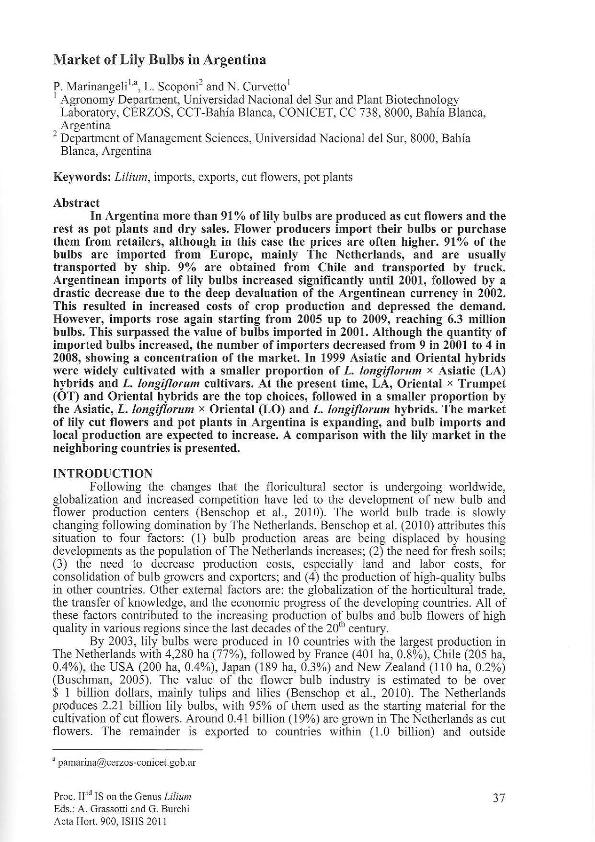Mostrar el registro sencillo del ítem
dc.contributor.author
Marinangeli, Pablo Alejandro

dc.contributor.author
Scoponi, Liliana

dc.contributor.author
Curvetto, Nestor Raul

dc.date.available
2017-07-03T14:16:36Z
dc.date.issued
2011-07
dc.identifier.citation
Marinangeli, Pablo Alejandro; Scoponi, Liliana; Curvetto, Nestor Raul; Market of Lily Bulbs in Argentina; International Society for Horticultural Science; Acta Horticulturae; 900; 7-2011; 37-41
dc.identifier.isbn
978-90-66052-29-1
dc.identifier.issn
0567-7572
dc.identifier.uri
http://hdl.handle.net/11336/19371
dc.description.abstract
In Argentina more than 91% of lily bulbs are produced as cut flowers and the rest as pot plants and dry sales. Flower producers import their bulbs or purchase them from retailers, although in this case the prices are often higher. 91% of the bulbs are imported from Europe, mainly The Netherlands, and are usually transported by ship. 9% are obtained from Chile and transported by truck. Argentinean imports of lily bulbs increased significantly until 2001, followed by a drastic decrease due to the deep devaluation of the Argentinean currency in 2002. This resulted in increased costs of crop production and depressed the demand. However, imports rose again starting from 2005 up to 2009, reaching 6.3 million bulbs. This surpassed the value of bulbs imported in 2001. Although the quantity of imported bulbs increased, the number of importers decreased from 9 in 2001 to 4 in 2008, showing a concentration of the market. In 1999 Asiatic and Oriental hybrids were widely cultivated with a smaller proportion of L. longiflorum × Asiatic (LA) hybrids and L. longiflorum cultivars. At the present time, LA, Oriental × Trumpet (OT) and Oriental hybrids are the top choices, followed in a smaller proportion by the Asiatic, L. longiflorum × Oriental (LO) and L. longiflorum hybrids. The market of lily cut flowers and pot plants in Argentina is expanding, and bulb imports and local production are expected to increase. A comparison with the lily market in the neighboring countries is presented.
dc.format
application/pdf
dc.language.iso
eng
dc.publisher
International Society for Horticultural Science
dc.rights
info:eu-repo/semantics/openAccess
dc.rights.uri
https://creativecommons.org/licenses/by-nc-sa/2.5/ar/
dc.subject
Lilium
dc.subject
Imports
dc.subject
Exports
dc.subject
Cut Flowers
dc.subject.classification
Otras Agricultura, Silvicultura y Pesca

dc.subject.classification
Agricultura, Silvicultura y Pesca

dc.subject.classification
CIENCIAS AGRÍCOLAS

dc.title
Market of Lily Bulbs in Argentina
dc.type
info:eu-repo/semantics/article
dc.type
info:ar-repo/semantics/artículo
dc.type
info:eu-repo/semantics/publishedVersion
dc.date.updated
2017-05-02T18:58:45Z
dc.identifier.eissn
2406-6168
dc.journal.volume
900
dc.journal.pagination
37-41
dc.journal.pais
Italia

dc.journal.ciudad
Pescia
dc.description.fil
Fil: Marinangeli, Pablo Alejandro. Consejo Nacional de Investigaciones Científicas y Técnicas. Centro Científico Tecnológico Conicet - Bahía Blanca. Centro de Recursos Naturales Renovables de la Zona Semiarida. Universidad Nacional del Sur. Centro de Recursos Naturales Renovables de la Zona Semiarida; Argentina
dc.description.fil
Fil: Scoponi, Liliana. Universidad Nacional del Sur; Argentina
dc.description.fil
Fil: Curvetto, Nestor Raul. Consejo Nacional de Investigaciones Científicas y Técnicas. Centro Científico Tecnológico Conicet - Bahía Blanca. Centro de Recursos Naturales Renovables de la Zona Semiarida. Universidad Nacional del Sur. Centro de Recursos Naturales Renovables de la Zona Semiarida; Argentina
dc.journal.title
Acta Horticulturae

dc.relation.alternativeid
info:eu-repo/semantics/altIdentifier/url/http://www.actahort.org/books/900/900_2.htm
dc.relation.alternativeid
info:eu-repo/semantics/altIdentifier/doi/http://dx.doi.org/10.17660/ActaHortic.2011.900.2
Archivos asociados
